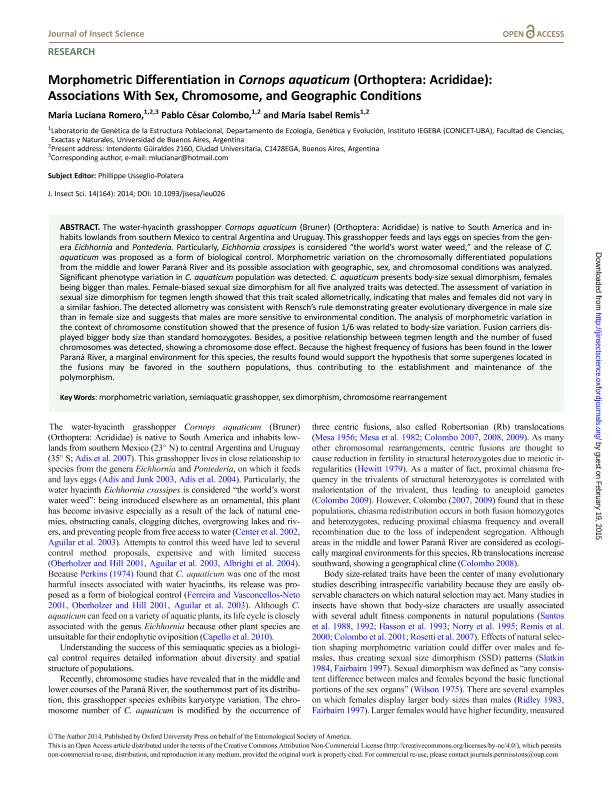Artículo
Morphometric differentiation in Cornops Aquaticum (Orthoptera: Acrididae): associations with sex, chromosome, and geographic conditions
Fecha de publicación:
11/2014
Editorial:
Oxford University Press
Revista:
Journal of Insect Science
e-ISSN:
1536-2442
Idioma:
Inglés
Tipo de recurso:
Artículo publicado
Clasificación temática:
Resumen
The water-hyacinth grasshopper Cornops aquaticum (Bruner) (Orthoptera: Acrididae) is native to South America and inhabits lowlands from southern Mexico to central Argentina and Uruguay. This grasshopper feeds and lays eggs on species from the genera Eichhornia and Pontederia. Particularly, Eichhornia crassipes is considered “the world’s worst water weed,” and the release of C. aquaticum was proposed as a form of biological control. Morphometric variation on the chromosomally differentiated populations from the middle and lower Parana´ River and its possible association with geographic, sex, and chromosomal conditions was analyzed. Significant phenotype variation in C. aquaticum population was detected. C. aquaticum presents body-size sexual dimorphism, females being bigger than males. Female-biased sexual size dimorphism for all five analyzed traits was detected. The assessment of variation in sexual size dimorphism for tegmen length showed that this trait scaled allometrically, indicating that males and females did not vary in a similar fashion. The detected allometry was consistent with Rensch’s rule demonstrating greater evolutionary divergence in male size than in female size and suggests that males are more sensitive to environmental condition. The analysis of morphometric variation in the context of chromosome constitution showed that the presence of fusion 1/6 was related to body-size variation. Fusion carriers displayed bigger body size than standard homozygotes. Besides, a positive relationship between tegmen length and the number of fused chromosomes was detected, showing a chromosome dose effect. Because the highest frequency of fusions has been found in the lower Parana´ River, a marginal environment for this species, the results found would support the hypothesis that some supergenes located in the fusions may be favored in the southern populations, thus contributing to the establishment and maintenance of the polymorphism.
Archivos asociados
Licencia
Identificadores
Colecciones
Articulos(IEGEBA)
Articulos de INSTITUTO DE ECOLOGIA, GENETICA Y EVOLUCION DE BS. AS
Articulos de INSTITUTO DE ECOLOGIA, GENETICA Y EVOLUCION DE BS. AS
Citación
Romero, Maria Luciana; Colombo, Pablo Cesar; Remis, Maria Isabel; Morphometric differentiation in Cornops Aquaticum (Orthoptera: Acrididae): associations with sex, chromosome, and geographic conditions; Oxford University Press; Journal of Insect Science; 14; 1; 11-2014; 1-8
Compartir
Altmétricas




